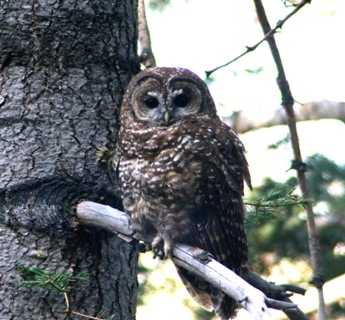Final Critical Habitat for Northern Spotted Owl Announced
Update: On November 21, 2012, the Fish and Wildlife Service designated 9.6 million acres of critical habitat for the Northern Spotted Owl. While this is an improvement over the  2008 critical habitat designation, which only protected 5.8 million acres, it is a substantial reduction from the 13.9 million acres originally identified by the FWS in February as possessing the physical and biological elements essential to the conservation of the owl. Back in its February proposal, the FWS announced that it was likely going to take steps to exclude large areas from the final critical habitat designation based on social and economic considerations. SCB submitted extensive COMMENTS explaining why such exclusions were not warranted and would have a negative impact on the owl. One particularly telling passage in the final designation demonstrates why the FWS’s current proposal falls short; it reads:
2008 critical habitat designation, which only protected 5.8 million acres, it is a substantial reduction from the 13.9 million acres originally identified by the FWS in February as possessing the physical and biological elements essential to the conservation of the owl. Back in its February proposal, the FWS announced that it was likely going to take steps to exclude large areas from the final critical habitat designation based on social and economic considerations. SCB submitted extensive COMMENTS explaining why such exclusions were not warranted and would have a negative impact on the owl. One particularly telling passage in the final designation demonstrates why the FWS’s current proposal falls short; it reads:
"the conservation role or value of northern spotted owl critical habitat is to adequately support the life-history needs of the species to the extent that well-distributed and interconnected northern spotted owl nesting populations are likely to persist within properly functioning ecosystems at the critical habitat unit and range-wide scales."
Merely ensuring that a federally threatened species, which is rapidly declining, is likely to persist on the landscape does not meet the legal standard for critical habitat under the
Endangered Species Act. Every Federal Court that has examined the issue of what the role of critical habitat should be has clearly stated that one of the central purposes of critical habitat is to promote the recovery of threatened and endangered species. By excluding 4.3 million acres of critical habitat, the FWS falls short in doing what is needed to move the owl’s recovery forward. Instead, the critical habitat designated on November 21 will, at best, preserve the status quo for the species. This decision, to exclude so much critical habitat, is deficient in that it does not meet the legal standards regarding the critical habitat as set forth in a Department of Interior Solicitor’s legal memorandum, which states:
"As habitat of a species is lost (or is made more vulnerable to loss due to exclusion), the remaining habitat may become more important to the conservation of the species, and the benefit of inclusion may increase. Thus, as the scope of the exclusions contemplated increases, the benefit of inclusion may increase in a more-than-linear manner, requiring a proportionately greater benefit of exclusion to outweigh it."
Equally problematic is the Service’s decision to promote untested “ecological forestry” within areas of the Northern Spotted Owl’s critical habitat. The promotion of “ecological forestry,” intended in part to increase timber yields in the Pacific Northwest, rather than the promotion of ecological restoration in the owl’s habitat means that timber extraction will continue to occur in the Northern Spotted Owl’s habitat. Timber extraction and the loss of old growth remain the primary cause of the owl’s decline. In April, SCB, The Wildlife Society, and the American Ornithologists’ Union wrote a LETTER to the Secretary of Interior asking that ecological forestry be scientifically tested and peer reviewed using the procedures under the National Environmental Policy Act prior to such logging projects being scaled up to commercial levels throughout the owl’s critical habitat. While the final rule contains some language suggesting that “ecological forestry” will be implemented in an adaptive management framework, conducting research on the effects of “ecological forestry” and adapting management actions in response remains an entirely optional decision of land management agencies and will not ensure the scientifically-rigorous evaluation of these practices required.
Finally, in its draft proposal, the FWS proposed that any ecological forestry project less than 500 acres in size would automatically not qualify as an action that would trigger the need for Section 7 consultations under the Endangered Species Act. Section 7 requires all federal agencies to consult with the FWS on proposed activities that may jeopardize the existence of any threatened or endangered species, or would adversely modify or destroy the species’ critical habitat. SCB’s comments were highly critical of this unprecedented approach to consultations under Section 7 of the ESA, because the law states that all consultations must be made solely on the basis of the best available science. The proposed 500 acre threshold had the potential of prejudicing the outcome of future consultations, potentially in violation of the ESA. The final critical habitat designation appears to have dropped this 500-acre threshold for consultations, which does represent a small improvement from the draft critical habitat proposal.
Although the new rule falls short of mandating strict protection for the spotted owl, the overall critical habitat designated on November 21 is a small positive step for the conservation of the Northern Spotted Owl. However, given the species’ continued and rapid decline, much more work needs to be done.